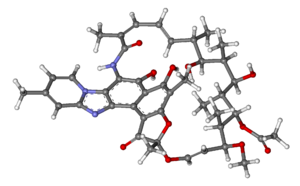利福昔明
 | |
 | |
| 臨床資料 | |
|---|---|
| 商品名 | Xifaxan, Zaxine, Xifaxanta, Normix, others[1] |
| AHFS/Drugs.com | Monograph |
| MedlinePlus | a604027 |
| 懷孕分級 |
|
| 给药途径 | 口服 |
| ATC碼 | |
| 法律規範狀態 | |
| 法律規範 |
|
| 藥物動力學數據 | |
| 生物利用度 | < 0.4% |
| 药物代谢 | 肝脏 |
| 生物半衰期 | 6小时 |
| 排泄途徑 | 粪便(97%) |
| 识别信息 | |
| |
| CAS号 | 80621-81-4 |
| PubChem CID | |
| DrugBank | |
| ChemSpider | |
| UNII | |
| KEGG | |
| ChEBI | |
| ChEMBL | |
| CompTox Dashboard (EPA) | |
| ECHA InfoCard | 100.111.624 |
| 化学信息 | |
| 化学式 | C43H51N3O11 |
| 摩尔质量 | 785.89 g·mol−1 |
| 3D模型(JSmol) | |
| 熔点 | 200至205 °C(392至401 °F) (分解) |
| |
| |
利福昔明(Rifaximin),商品名Xifaxan,是一种用于治疗旅行者腹泻,肠躁症和肝性脑病的抗生素。 [3] 由於利福昔明的口服吸收率相當低,只有0.4%會吸收到血流中[4],因此可以在腸道達到相當高的藥物濃度。
医疗用途
肠躁症
利福昔明在美国核准用于治疗肠躁症 。 [5] 它具有抗發炎和抗菌效果,且難被腸道吸收入身體循環,因而能在肠道發揮局部作用,有效缓解非便秘型肠躁症 (IBS)的慢性功能症状。即使反复使用似乎仍能保持效果。 [6] [7] 利福昔明特别适用于怀疑腸躁症與小肠细菌过度生长有關的病人。
困難梭菌感染
利福昔明可能可以與萬古黴素併用以治療复发性困难梭菌感染。 [8] [9] 不過這些研究的證據等級不高。[10]
肝性脑病
雖然缺乏良好证据,但利福昔明似乎与其他現有的肝性脑病治疗方法(如乳果糖 )一样有效,耐受性更好,并且可能更快發生效果。 它可減少肠道中产生氨的细菌,而能減轻肝性脑病的症状,降低了死亡率 。 [11] 利福昔明的缺点是比較昂貴,且目前對於肝性腦病患者,缺乏未併用乳果糖治疗的临床试验。
特别注意
对于Child-Pugh评分为C级严重程度的肝硬化患者 ,必须谨慎使用。 [11]
副作用
由於本藥由腸胃道吸收程度不高,全身性副作用不多,副作用一般而言輕微並不常見 [6] 除非存在诸如免疫抑制和住院等危险因素,否则艰难梭菌感染通常不是由利福昔明疗法引起的。 利福昔明对艰难梭菌具有活性。
参考文献
- ^ Rifaximin international. Drugs.com. 2 November 2020 [11 November 2020]. (原始内容存档于2023-07-14).
- ^ Xifaxan- rifaximin tablet. DailyMed. 1 October 2019 [11 November 2020]. (原始内容存档于2023-03-22).
- ^ Rifaximin. The American Society of Health-System Pharmacists. [8 January 2017]. (原始内容存档于2020-03-01).
- ^ Adachi, J. A., & DuPont, H. L. (2006). Rifaximin: a novel nonabsorbed rifamycin for gastrointestinal disorders. Clinical infectious diseases, 42(4), 541-547.
- ^ Rifaximin for the treatment of diarrhea-predominant irritable bowel syndrome. Expert Rev Gastroenterol Hepatol. 2016, 10 (4): 431–42. PMID 26753693. doi:10.1586/17474124.2016.1140571.
- ^ 6.0 6.1 Rifaximin for the treatment of irritable bowel syndrome - a drug safety evaluation. Expert Opinion on Drug Safety. July 2016, 15 (7): 983–91. PMID 27149541. doi:10.1080/14740338.2016.1186639.
- ^ Clinical Practice Guidelines for Irritable Bowel Syndrome in Korea, 2017 Revised Edition. Journal of Neurogastroenterology and Motility. April 2018, 24 (2): 197–215. PMC 5885719
 . PMID 29605976. doi:10.5056/jnm17145.
. PMID 29605976. doi:10.5056/jnm17145.
- ^ Interruption of recurrent Clostridium difficile-associated diarrhea episodes by serial therapy with vancomycin and rifaximin. Clinical Infectious Diseases. March 2007, 44 (6): 846–8. PMID 17304459. doi:10.1086/511870.
- ^ A randomized, double-blind, placebo-controlled pilot study to assess the ability of rifaximin to prevent recurrent diarrhoea in patients with Clostridium difficile infection. The Journal of Antimicrobial Chemotherapy. December 2011, 66 (12): 2850–5. PMID 21948965. doi:10.1093/jac/dkr377.
- ^ Antibiotic treatment for Clostridium difficile-associated diarrhoea in adults. The Cochrane Database of Systematic Reviews. March 2017, 3: CD004610. PMC 6464548
 . PMID 28257555. doi:10.1002/14651858.CD004610.pub5.
. PMID 28257555. doi:10.1002/14651858.CD004610.pub5.
- ^ 11.0 11.1 Profile of rifaximin and its potential in the treatment of irritable bowel syndrome. Clin Exp Gastroenterol. 2015, 8: 159–67. PMC 4467648
 . PMID 26089696. doi:10.2147/CEG.S67231.
. PMID 26089696. doi:10.2147/CEG.S67231.
| |||||||||||||||||